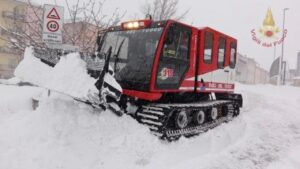On the first day of November in Braemar, Aberdeenshire, there is a bitter chill in the air and the temperature hovers around 6C. This is balmy autumn weather for the village, nestled at the foot of the Cairngorm mountains and holder of the unenviable title of Britain’s coldest place, having recorded record low temperatures of -27.2C twice in the past 40 years. Just last year, the village experienced Britain’s coldest night since 1995, when temperatures dropped to -23C in February.
Braemar’s temperatures are thought to reach such extremes because of its geography, with the encircling mountains essentially turning the village into a “bowl” in which cold air blows down from the mountaintops and becomes trapped. In the coming months, residents can expect temperatures in the -20s accompanied by heavy snowfall, ice and storms. But while people in Braemar are well prepared for the weather, little can shield them from energy prices surging here as across the country.
“When I was little, you ate your tea with the Calor gas stove and no lights on to try to save energy – I can’t believe we’re actually going to go back to that,” says Hazel Williams.
“To not have your heating on in the winter here would be highly dangerous, so you don’t have much choice,” adds Williams, manager of Braemar’s Highland Games Centre.
“I think people feel a bit stuck and a bit cornered. They’re definitely worried about heating their homes this winter.”
Cold weather can be so extreme in Braemar that buildings are designed with it in mind. The Highland Games Centre, completed in 2018 and home to the Braemar Gathering, boasts heated pipes and drains to stop heavy snowfall from weighing down the roof, and to prevent icicles from pulling gutters down.
Newer homes, too, are built with metal grates in their roofs to ensure gathered snowcannot fall and damage cars. But the village also hosts a number of historic buildings and homes, many of which are listed and therefore single-glazed and uninsulated.
“Here, you wake up in the morning and there’s ice on the inside of your windows, and it’s only light between 9am and 3pm,” says Williams. “You have to have the lights on; you have to heat your home. It’s a lot scarier to face winter in Braemar at the foot of the hills than it is in London, for example.”
While Braemar, almost 100 miles north of Edinburgh, is a relatively affluent town with a reliable rotation of tourists, it is also home to a number of council tenants who found themselves at the centre of a row this year when Aberdeen council announced now-paused plans to replace coal fires with central heating in order to meet environmental targets.
Coal fires remain the cheapest way of heating a home, and are standard in many of Braemar’s older houses, but the price of logs and coal has also increased. Last month, a new “log bank” was announced whereby surplus wood donated by local landowners will be distributed via a food bank.
“I think a lot of folk are very nervous about what they’re going to do,” says butcher Gareth Johnston. “I’m worried – we’ve already left it about a month later than usual to start putting the heating on and I daren’t put it on at peak times.
“But I don’t know what else folk are supposed to do except suck it up and see what happens when the bill comes. You can’t just freeze to death.”
Extreme weather has become less predictable in recent years, says Johnston, with reliable snowfall making way for short and sharp storms that often arrive with no warning.
“It’s almost like we’re going back in time,” he says. “When I was a kid, my mum always had candles, torches … essentially a storm pack set up for the winter. We’ve never needed one until this last year. Everything’s supposed to be better, technology’s supposed to be better, but it’s like we’re going back to the 50s or 60s.”
Dave Evans, owner of the Braemar Brewing Company, housed in a building shared with his wife’s patisserie shop and, upstairs, their family home, is also feeling the effect of rising energy prices on his small business.
“My energy bills have gone up five-fold, from about ?450 to over ?2,000,” he says. “I’ve had to put my prices up because prices have gone up across the board – not just energy but deliveries, products, everything.”
Evans’s wife’s patisserie shop is now closed for the winter, the drop in tourist numbers making it untenable to keep heating and lighting the space to the same level in the quiet months. But there is no option to simply shutter some buildings and heat others instead, Evans says. “When it does get down to -20 and below, the pipes start to freeze and then you have much bigger problems to deal with, so you have to keep things going.
“There will be people struggling this winter. There already are,” he says. But, Evans hopes, the community will take care of those in need. During last November’s Storm Arwen, the Fife Arms Hotel in the centre of the village used its backup generator to provide hot meals and somewhere warm for those left without power for days.
“People here are very resilient and everybody mucks in, whether it’s food, shelter or shovelling snow,” says Evans.
“People will look after each other – that’s just small village life.”





